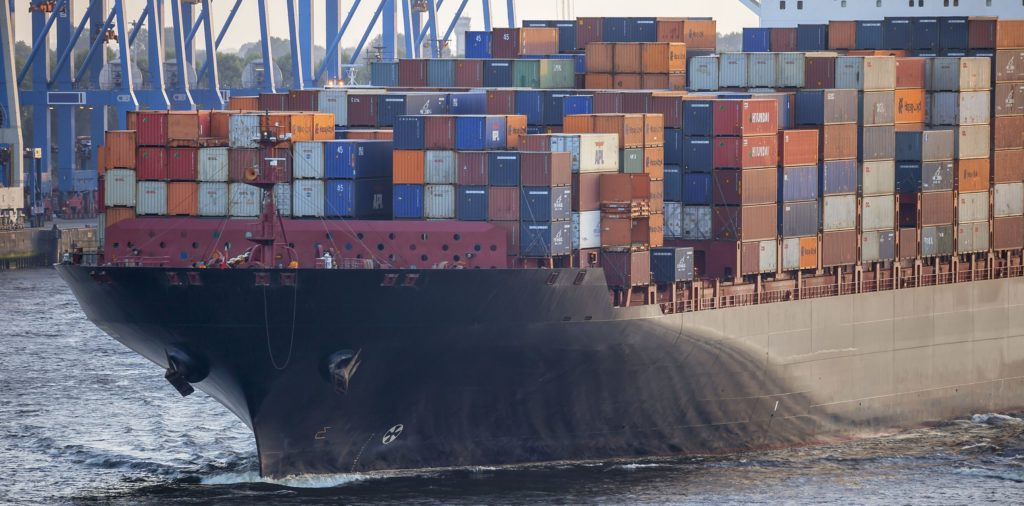Political tensions between the U.S. and China are contributing to lower container shipments between the world’s two largest economies, on top of an already-underway reshaping of global trade, according to a major shipping industry boss.
“We are seeing a de-leveraging of trade between the U.S. and China,” Jeremy Nixon, chief executive officer of Ocean Network Express, said at the Capital Link Singapore Maritime Forum. “Many companies in the U.S. are looking to reduce down the amount of imports they have got coming from China.”
Nixon said the share of container boxes arriving in the U.S. from China has fallen by about 10 percentage points over the past year. As a result, the U.S. is establishing stronger ties with other trade partners including Europe, a trend Nixon says will continue.
The world’s two largest economies have been steadily becoming less interdependent over the past year. This was largely due to the widespread slowdown in the global economy which was particularly acute for containers as the demand boom reversed during the pandemic. Nixon added that the U.S.-China decoupling is currently being worsened by geopolitics.
The U.S. has been importing more from Europe. Additionally, shipping flows from the Mediterranean, India and Southeast Asia into the U.S. have also been bolstered, Nixon noted.
Source: Transport Topics
AfA Says Air Cargo Industry Lagging on Lithium Battery Detection
Lithium batteries are a significant problem for air cargo due to the complex regulations governing their transportation, said Airforwarders Association’s Executive Director, Brandon Fried, during IATA’s World Cargo Symposium. “We’re falling behind in the lithium battery detection and management of transportation,” Fried told Air Cargo Next.
If mishandled, batteries can catch fire, making them high-profile hazards for stakeholders, including regulators, shippers, forwarders, carriers, and ground handlers. According to current regulations, lithium batteries cannot be shipped more than 30% charged.
“What happens when you have a manufacturer or shipper that tenders cargo that might be at 100% state of charge?” Fried said. “How will you know, as an airline, as a freight forwarder? And the governments aren’t stepping up; they’re not helping us here.”
Fried suggested that one solution to help shippers detect danger in the cargo they transport could be using dogs to detect lithium levels. “I say let’s get more dogs out to the airport,” he said. “Because here’s the thing: We can talk about fire-resistant containers and coverage for containers only. They’re expensive — they cost a lot of money because they weigh 40 and 50 pounds each. And there are hundreds of containers out there. Suppose you’re wrong, and you get an undeclared box in a container full of paper. Now you have a fire that’s been in the container.”
“You know, obviously we’re going to do what we think is best, but the governments have to be in consultation with us,” Fried said.
Source: Air Cargo Next
Vancouver Prepares to Build C$3.5 billion Mega-container Terminal
Canada’s Vancouver Fraser Port Authority has received conditional environmental approval from the federal government for a planned C$3 billion mega-container terminal – the Roberts Bank Terminal 2 or RBT2. Upon completion of RBT2, container capacity would rise by nearly 50% at Canada’s largest port.
The port authority has been looking for a new terminal for two decades and says it could open facilities in the early 2030s. However, it must first meet 370 legally binding conditions tied to environmental and wildlife regulations and Indigenous land rights.
According to the port authority, the RBT2 terminal would have an annual capacity of 2.4 million TEU and will allow Canada’s largest container gateway enough capacity to avoid congestion while growing volumes. The agency says the gateway will reach capacity in the middle to late part of this decade. A recent DP World terminal expansion has given the port some capacity in the meantime.
Vancouver has experienced sporadic spikes in congestion in recent years, often associated with poor weather and strong import volumes. However, it was a shortage of railcars rather than berth space that caused turmoil last year.
In February, the International Longshore and Warehouse Union Canada, which is negotiating a new contract with West Coast waterfront employers, told Canadian Prime Minister Justin Trudeau that automation at RBT2 would cost the country jobs. ILWU Canada’s existing contract allows for some automation, and port experts say that some degree would have to be deployed at RBT2 given the scale of the project.
Source: Journal of Commerce
US$27 million Investment in California’s Five Ports for Data System to Improve Supply Chain
Five California ports will receive a $27 million state grant to develop a shared data system aimed at improving the efficiency of cargo operations. The Governor of California, Gavin Newsom, signed a memorandum of understanding (MOU) to launch the California Port Data Partnership and announced the funds were to be shared by the ports of Long Beach, Los Angeles, Oakland, San Diego and Hueneme.
“As California’s population continues to grow and demand for imported goods continues to surge, it is vital that our state prioritize investments that will get goods moving faster,” said California Association of Port Authorities President and Port of Oakland Executive Director Danny Wan.
The MOU outlines an agreement between the five ports to jointly advance computerized and cloud-based data sharing with a common goal of supporting improved freight system resilience, goods movement efficiency, emissions reduction, and economic competitiveness.
The 11 major commercial ports that comprise the California Association of Port Authorities handle 38% of all U.S. containerized imports and 28% of all exports. Collectively, the California Ports are the most consequential system of ports in the nation.
Source: American Journal of Transportation
Year-over-year comparisons can be augmented by comparisons to the same month in 2019 before any pandemic impact. Inbound loads this January compared to January 2019 equated to a four-year CAGR of negative 1.4%, according to Blue Alpha Capital.
Source: splash247.com
U.S. Truckload Market Deals with Headwinds
The shipment components of the Cass Freight Index declined -1% month-on-month (m/m) in March as freight markets continued to work through an extended soft patch.
“Mild weather this winter and Omicron a year ago supported volume comparisons in January and February, so the lower result in March was unsurprising,” according to ACT Research Vice President Tim Denoyer.

On a year-on-year (y/y/) basis, the index reported a -4% decline; compared to 2021, the reading was -3.4% lower.
“Soft real retail sales trends and ongoing destocking remain the primary headwinds to freight volumes, and sharp import declines suggest this type of environment will persist for some time,” according to ACT Research Vice President Tim Denoyer.
Source: Cass Information Systems




